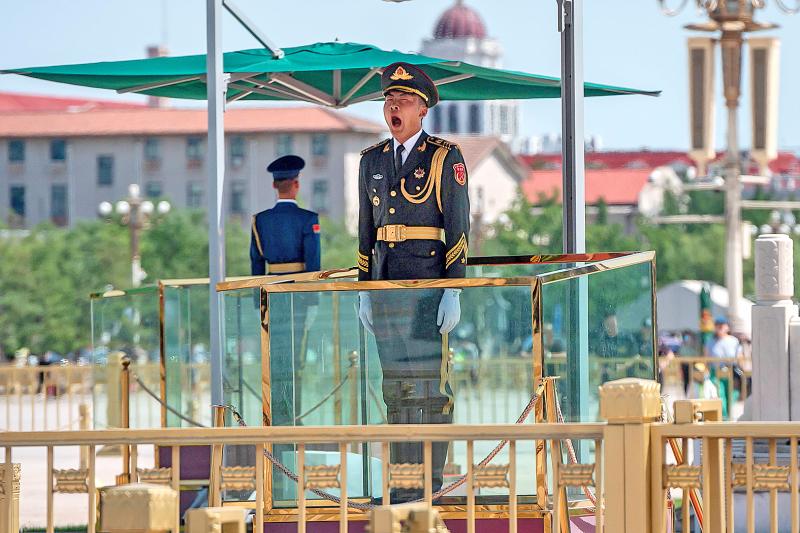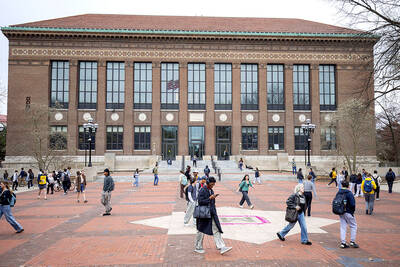It was mid-morning in Tiananmen Square in Beijing on June 1, 1989. Someone had turned on a boom box playing 1980s disco music, and people began to dance.
A young couple spins in a small opening in the crowd. The woman smiles slightly, her eyes almost closed, as her partner in a loose dress shirt and blazer turns her.
Around them, people are clapping.

Photo: AFP
It is a photograph that captures a side of the pro-democracy movement often overshadowed by what came after — a brutal military crackdown on the evening of June 3 and morning of June 4.
There is no official death toll, but activists believe hundreds, possibly thousands, were killed.
More than 30 years later, Zhou Fengsuo (周鋒鎖), a student leader in Beijing who was later jailed, remembers the scene.
“There was a lot of celebration. For the first time, you see this freedom in the air, that inspired people to celebrate to be hopeful and be joyful in Tiananmen Square, the symbol of power in China. That’s the most inspiring story of 1989,” Zhou said.
Throughout the six-week occupation of the square, there were many lighter moments: protesters giving out birthday cake; people sharing breakfast and tea; someone giving another demonstrator a haircut.
Unofficial weddings were held.
“Tiananmen was China’s Woodstock without mud, but plenty of blood,” said Rose Tang (唐路), who attended the protests in Beijing as a university student. “It was the first time for the Chinese since 1949 to truly have a little taste of freedom as individuals and a taste of organic community spirit.”
However, by the end of May 1989, the protests had begun to wane and protesters were tense. Authorities had declared martial law on May 20 to stamp out the weeks of marches, sit-ins and hunger strikes led by students who had inspired sympathy and support across the country.
Troops had tried to move into the capital, where they were blocked by civilians. There had been rumors the night before that the Chinese military would soon clear the square.
On the morning of June 1, those who stayed overnight to guard the square were relieved to find their tents and the Goddess of Democracy, erected just a few days earlier, still standing.
“When they woke the next morning and the army didn’t come, there was this exhilarated feeling of: ‘We survived,’” said Mark Avery, the then-staff photographer for The Associated Press who took the picture of the couple.
That day would be one of the last moments of peace in the square.
Children gazed up at the 10m-tall Goddess of Democracy, made of wire and papier-mache.
Students, workers and residents talked and sang songs, said Jiang Shao (江邵), another former leader of the protests, who was there in the afternoon.
“These scenarios were very rare after martial law,” he said.
After the Tiananmen Square Massacre, or the “June 4 Incident” as it is now described in China, such scenes were expressly forbidden as authorities moved quickly to erase the chapter from the public memory.
“The thing that really floored me was the Orwellian silence afterwards,” said Avery, who stayed in Beijing until 1991, working under martial law that was kept in place until the year after the crackdown.
“Afterwards, everything out of people’s mouths was the party line. Nobody was having conversations. It was just mind-boggling,” he said.
Today, it is unclear what happened to the young dancing couple in the photograph taken by Avery. They were not prominent student leaders. Most likely, they were university students from outside Beijing, based on the little pins visible on their shirts.
Students in Beijing tended not to wear theirs, Zhou said.
They might have been caught up in the violence or arrested. If they escaped and live in China today, it is likely they have moved on, helped by the government’s glossing over of the events.
“We don’t know. We’ll never know. I don’t know if they would still remember this day,” Zhou said. “They were just ordinary people.”

Swedish campaigner Greta Thunberg was deported from Israel yesterday, the Israeli Ministry of Foreign Affairs said, the day after the Israeli navy prevented her and a group of fellow pro-Palestinian activists from sailing to Gaza. Thunberg, 22, was put on a flight to France, the ministry said, adding that she would travel on to Sweden from there. Three other people who had been aboard the charity vessel also agreed to immediate repatriation. Eight other crew members are contesting their deportation order, Israeli rights group Adalah, which advised them, said in a statement. They are being held at a detention center ahead of a

A Chinese scientist was arrested while arriving in the US at Detroit airport, the second case in days involving the alleged smuggling of biological material, authorities said on Monday. The scientist is accused of shipping biological material months ago to staff at a laboratory at the University of Michigan. The FBI, in a court filing, described it as material related to certain worms and requires a government permit. “The guidelines for importing biological materials into the US for research purposes are stringent, but clear, and actions like this undermine the legitimate work of other visiting scholars,” said John Nowak, who leads field

Former Nicaraguan president Violeta Chamorro, who brought peace to Nicaragua after years of war and was the first woman elected president in the Americas, died on Saturday at the age of 95, her family said. Chamorro, who ruled the poor Central American country from 1990 to 1997, “died in peace, surrounded by the affection and love of her children,” said a statement issued by her four children. As president, Chamorro ended a civil war that had raged for much of the 1980s as US-backed rebels known as the “Contras” fought the leftist Sandinista government. That conflict made Nicaragua one of

NUCLEAR WARNING: Elites are carelessly fomenting fear and tensions between nuclear powers, perhaps because they have access to shelters, Tulsi Gabbard said After a trip to Hiroshima, US Director of National Intelligence Tulsi Gabbard on Tuesday warned that “warmongers” were pushing the world to the brink of nuclear war. Gabbard did not specify her concerns. Gabbard posted on social media a video of grisly footage from the world’s first nuclear attack and of her staring reflectively at the Hiroshima Peace Memorial. On Aug. 6, 1945, the US obliterated Hiroshima, killing 140,000 people in the explosion and by the end of the year from the uranium bomb’s effects. Three days later, a US plane dropped a plutonium bomb on Nagasaki, leaving abut 74,000 people dead by the